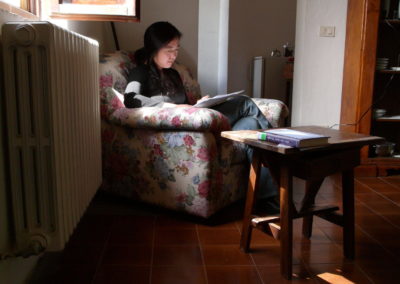I worked on several projects while at Civitella: translation project, a collection of essays, and a novel. What they all have in common is the idea of translation, whether translation between languages, cultures or emotions. This time at Civitella gave me a pocket of uninterrupted time to start these project. While working, I am constantly struggling to find time between teaching writing and my own writing. It is easier when I am working on a shorter piece; however, when I am working on a longer piece, I need as much uninterrupted time and space as possible to excavate how the story will unfold, sentence by sentence, scene by scene. The mode of thinking required is at least a month, where every hour is dedicated to the vision of the story, not fragmented like in our daily lives, where we are allowed to make mistakes, to pause, yet carry the internal voices of characters and architecture of the narration inside of us. Civitella, with its beautiful landscape and quiet, gave me all of that.
Excerpt from Instruction for the Living
A man dies. It was a mechanical death for, in our time, death is named, reasons attested and written off. We have learned to keep death at bay, with the boundary between the living and the dead as clearly marked as the borders between nations. We do not understand the language of medicine; the hospital room becomes the promised land, and our home is an exile from that.
A man lies with his mouth slightly open and his eyes rolled upward, with only their whites showing. Death, the nameable, cannot be exacted: it is not the sickness – cancer – that he died of. Instead, heart failure. No matter. He is dead. This is a cadaver.
There is no time to mourn. Not yet. We must prepare the body. It is not the job of the mourners, no; it is the job of the hospital’s workers.
They will pull out the tubes that kept the body alive. They will clean it from head to toe with alcohol; they will suck out various liquids with thick needles, and they will stuff its orifices with cotton.
Nurses will place a ribbon around its jaw to keep its mouth closed; they will force its hands into the shape of a prayer before the body hardens. They have tied the hands, as if binding them as if it were a criminal; but the only crime the dead have committed is to die, betraying the mission of the hospital and the selfish will of the living.
We will not see this; we are ushered out, and while the nurses are remolding this man into a dead body, the living must declare itdead and prepare for itstransportation from the hospital. After all, hospitals are for the living, not the dead.
The permission to transport the body is now signed and ready. The living are bound to permissions, both tangible and invisible, and so are the dead. Doctors and nurses line up by the side entrance, away from the eyes of patients who fear the same exit, and bid him farewell.
As the dark station wagon slowly depart, they bow deeply and do not straighten their backs until the car has disappeared from view. It is the small gesture they can make to honor the body’s final fight, to honor the man who went through surgeries and chemotherapy, almost transforming him – it–into pain itself- but not quite.
Go home. There is no need to stay at the hospital.
But before you go home, call the relatives, for they also must be there to welcome it home. The soul of the departed will already be there, waiting, observing. Behave, for the dead will be watching. Once it arrives, we must lay it out in the living room, its head facing north, because that is where the gate between this world and the other lies, because the soul needs to know that this is no longer his home.
The body arrives.
You will not know what to do because, although anonymous death happens every minute, the personal one does not. You must call the professionals, those who know what to do. And they come, in an hour.
The undertaker, sitting in the corner as if he is a part of a shadow, will tell you how sorry he is to hear of the death. There is no convenient time for death, he says. He says that every hour is the hour of dead. He is the guide who ushers the mourners forward through this journey, accompanying the dead to the other world. He is the only one who can give meaning to the unintelligible ritual of the funeral.
The sign is posted by the gate: there is a dead



